
The best places to buy prescription glasses online in 2023
Ordering glasses online used to be something you did as a last resort, a way to pick up a budget pair or just to try something new without breaking the bank. But with more and more fashion-forward brands online than ever, venerable brick-and-mortar opticians launching web shopping and the industry as a whole embracing the idea, it’s easier than ever to get that new look or get that new prescription with a few clicks.
We tried a dozen of the leading online eyeglass retailers, and after months of shopping, measuring, ordering and wearing the results for work, workouts and everyday, we’ve found the best online eyeglass retailers for you, whether you’re looking to save money, find something specific you can’t get close to home or just want access to the widest range of styles.
The best place to buy prescription glasses online overall
A huge selection of name and house brands and great try-on tools make it easy to find what you want, and the retailer made us a great pair of glasses. A short return period is the only real downside
The best online eyeglasses on a budget
With the lowest prices on average and an ever-expanding catalog of frames and lenses, Zenni’s the least expensive way to get great glasses online. You’re locked into store credit if you don’t like your glasses, but there’s a lot to choose from even so.
The best place to buy performance glasses and workout sunglasses
It’s hard to find great performance frames even at most optical shops, and Roka’s stylish, lightweight, nonslip glasses are great for anybody active.
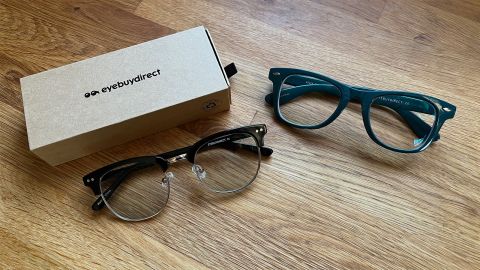
With a mix of affordable house brands and good deals on a range of premium brands, Eyebuydirect offers flexible, complete search tools and a shopping process that is smooth and easy to navigate, with superior VR/AR try-on tools. If you’re looking for value comparable to Zenni’s but want the option of browsing familiar names, it’s hard to beat.
Eyebuydirect’s collection is huge, which means you’ll find both a wide range and a lot of variations on similar themes. The search tools let you filter effectively by enough criteria that you can narrow things down quickly.
We really liked the glasses we got from Eyebuydirect, especially given the inexpensive pricing. The fully spec’d browline pair we ordered compared very favorably to name-brand versions of the same concept from Ray-Ban and others, with solid build, very clear optics and a wide field of vision in the premium progressive prescription we ordered, and the fit was in order with what we’d expected from the online fit tools. A pair of basic Wayfarer-style frames we ordered as readers similarly met our expectations, with quality acetate construction and similarly good optical quality to the pricier pair.
Basic single-vision prescriptions are very inexpensive (well under $100), while pricing for a fully loaded pair, before discounts, runs about $400 for house brands ($100 more than Zenni) and in the $500 to $600 range for branded options like Ray-Ban. This is still very affordable compared to many brick-and-mortar opticians and high-end retailers, where you’d spend in the neighborhood of $1,000 for a similarly spec’d pair but not far off major discount retailers like Costco.
Eyebuydirect’s try-on tools are the most complete and easy to use of all of the eyeglass retailers we tested. A full-featured viewer works with your live webcam, an uploaded still image or a recorded video, and lets you enter your PD measurement and even adjust the fit of the virtual frames on your nose, which we didn’t encounter anywhere else — it really makes the fitting experience better and gave us the best sense of how the frames might look when worn.
Like most low-cost online retailers, Eyebuydirect doesn’t directly accept insurance, but the site provides a simple way of applying for reimbursement from a wide range of vision insurance plans, potentially saving you money even over other lower-cost online retailers, depending on your plan’s out-of-network coverage.
Two-day delivery (one day faster than even Zenni’s express service) is available for a select range of frames, with single-vision prescriptions — it’s about the cheapest way to get a pair of glasses in a hurry. With regular shipping, we got our glasses in nine business days.
Interestingly, and perhaps understandably given the need to keep down costs, you don’t get a case with your Eyebuydirect glasses — just a cardboard box. If you’ve bought glasses in the past this is probably welcome (since there’s definitely a drawer full of excess cases somewhere in your house), but it can be a little inconvenient if you’re new to eyewear.
You have only 14 days to return your glasses if you don’t like them, among the shortest return periods of any online glasses retailer we looked at. That said, you do get a full refund (unlike Zenni, where you get a 30-day window but only store credit), so if you don’t like their styles, you can easily recoup your investment and shop elsewhere.
While overall Eyebuydirect’s frames are of good quality and comparable to everything else in the under-$300 price range that we saw, some of the more basic plastic frames we checked out did feel a bit cheap by comparison with Zenni’s similarly priced frames. We don’t expect they’d fail in use or anything, but if you want a luxury feel you might not want to select the least expensive frames on offer here — Zenni has a slight edge here at the low end.
One flaw in Eyebuydirect’s ordering system — which most people might not find an issue, admittedly — is that it doesn’t flag multifocal prescriptions that are out of spec for a given frame until you’ve made your way through most of the ordering process (and the alert doesn’t give enough clear advice on what to do or what’s wrong). We’d prefer to see this alert earlier in the process.
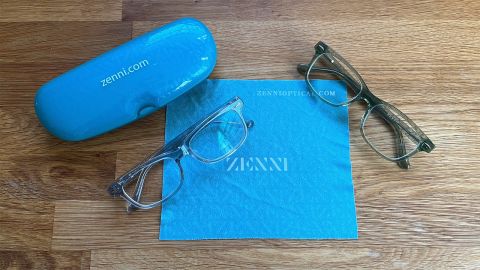
Zenni’s pricing has always been hard to beat, but as the company has expanded its range of styles and options, it’d be hard to recommend that online glasses shoppers looking to save money go anywhere else. Zenni also has the best shopping tools and prescription management of any of the online glasses retailers we looked at, and its prescription entry tool was the most flexible of the bunch, even letting you manage multiple orders for different members of a family. If Zenni’s styles work for you, you really can’t lose.
Zenni has been a consistently popular choice because it sells a full-featured pair of glasses for significantly less on average than its competitors. It’s possible to get a pair with all the fixings — premium, high-index progressive lenses, with the latest Transitions XtraActives photochromic treatment and a full suite of protective coatings — for under $300, even before coupons or discounts. Plus, the company has made the shopping and ordering process among the simplest and most straightforward of all the retailers we looked at for this review.
The company’s offerings have expanded over time, and while styles tend toward bright, fun colors and fashion-forward looks, you can get anything from classic wire rims to wraparound nylon activewear models at this point. Everything is well made, with quality fittings like spring hinges employed across the line. That said, Zenni’s glasses don’t have the fine-tuned, substantial feel you’d get from a luxury frame — Zenni’s acetate finishing is not always up to the level of a Moscot or Salt frame, for instance — but at the price is a whole lot of bang for the buck. The pairs we received were all solidly built, with no creaking or looseness, and adjustments were easy to make where needed. Nothing feels cheap here.
If you already know what you like (or just prefer precision), you can search the company’s catalog by almost any parameter you can think of, from color to any frame or lens dimension, by specific number or range. It’s just better than any other site we tried (though Eyebuydirect gets pretty close). Zenni’s virtual try-on tool lets you see every frame on a search result page already displayed on your face, a helpful guide for comparison shopping.
The prescription data entry tool is simple and straightforward (it was surprisingly obscure on several competitor sites), and we found it easy to place orders for multiple prescriptions for different people within the same order, which was not the case for the great majority of eyeglass retailers we checked out. There’s also great account-based record-keeping, which regular customers will appreciate, making it easy to revisit past orders, reorder and keep prescriptions organized. On tools and pricing, Zenni sits comfortably at the top of the heap.
Zenni offers a limited selection of frames with single-vision prescriptions with a “Fast Frame” three-day delivery guarantee. But even outside of the models covered by the two-day offer, shipping is very fast (we received one of our orders, a pair of progressive, photochromic curved exercise glasses — a tall order for most manufacturers — in seven business days, and the others within two weeks).
While Zenni will make almost anything, there are limits — for instance, it’s optically challenging to make progressive prescriptions in a highly curved lens, and to avoid distortion most manufactures don’t make stronger prescriptions (+/- 4.00 or above) in that format.
Luckily for Zenni shoppers, rather than simply kicking you back to the beginning of your order without clear explanation (as we found with GlassesUSA), the Zenni site gives you an informative alert when you’ve tried to order something that’s gone over the line, making it easy to figure out what to do.
Zenni’s main downside is that though it has a 30-day no-questions-asked return policy, you can only return for store credit (toward another pair of Zenni frames) or you can choose a 50% refund. If you find after trying them on that you don’t like the overall look or feel of Zenni’s frames or lenses, you’re out of luck. That said, the typically low prices offset the potential loss (and the range of styles is broad enough you’ll likely be fine with one of the looks, at least as a spare pair), but it’s worth keeping in mind.
There’s no in-home sample try-on available, either as part of shopping or fitting — that’s in keeping with most of the lower-priced competition, but the company would be very hard to quibble with at all if they offered such a thing.
Annoyingly, Zenni doesn’t put measurements on their frames. While it’s easy enough to look these up in your account on the Zenni site, it’s nice to have the numbers handy if you ever want to look elsewhere in the future. Like the return policy, it seems calculated to keep you in the Zenni ecosystem, which is understandable from the company’s perspective but is not particularly consumer-friendly.
The best place to buy performance glasses and workout sunglasses: Roka
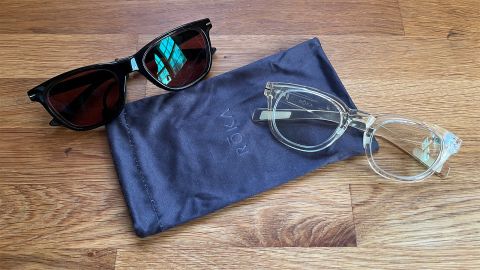
Roka has carved out an interesting niche. It offers a small number of fashionable styles, but all with an activewear focus. With lightweight nylon frames, replaceable (and adjustable) nonslip nose pads and arm contact points used in all of the frames the company sells, these glasses are always ready for action. The range of styles is much more limited than most of the online eyeglass brands, but the focused approach is much like the one Apple’s taken with the Apple Watch Ultra: These glasses are meant to be high-end fitness devices that you can wear all the time.
We’ve been running and cycling and doing outdoor chores for several months using a pair of Roka’s Hamilton frames, and we’ve found them as comfortable and nonslip as claimed, comparing very favorably with mainstream performance models from Oakely, Tifosi and other specialist brands. They’re also stylish and have great optical clarity, as good as anything we saw from any of the makers we tested.
The replaceable “Geko” nose pads (you get three sizes in the box, much like you might with silicone ear tips for earbuds) really make a difference in getting a secure nonslip fit even when you’re sweaty — they really stay put, even when running or cycling on a hot, humid day, a challenge for every other frame we tried. The three sets of nose pads made it easy to get a good fit, and there’s a good few millimeters of variation available.
Roka doesn’t offer a huge variety of styles — you mostly get a bunch of variations on the slightly oversized chunky look, though in lightweight materials and with a gentle curve for better performance, along with some vintage-style looks and a few mixed material and browline styles. It’s utilitarian, but uniformly good-looking and should suit a wide variety of faces.
Roka has a 30-day return policy, though it deducts a $20 restocking fee (waived if you’re returning because the company didn’t get your prescription right). This isn’t that significant a cost given the relative expense of the glasses themselves, so we consider it a reasonably good policy in the context of the brands we reviewed for this piece.
If you don’t have a current prescription, Roka partners with the online vision test provider Visibly to offer a virtual vision test. There’s a $25 fee for the service. We didn’t assess this for purposes of this piece (and may return as more of these services emerge), but the option is there and integrated with the process.
Roka is relatively expensive compared to many of the other brands we checked out, with a fully decked-out pair of photochromic progressives costing around $750. While this is probably offset for most potential buyers by the fact it’s actually pretty hard to find good performance eyewear even at most brick-and-mortars, especially if you don’t like the sci-fi look of Oakely’s offerings, keep in mind that you won’t save a ton of money over the in-store experience.
As of this writing it appears that Roka has discontinued its in-home try-out option, which we appreciated during the shopping process.
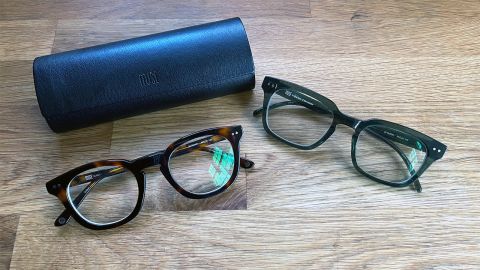
GlassesUSA, a sizable online retailer that’s part of Optimax, one of the big international eyewear companies, offers a huge selection. With a ton of familiar name brands along with house brands such as Muse, Ottoto and Revel, there’s likely to be something you’ll like here, whether you’re looking for oversized aviators or chunky acetate, retro or futuristic.
Shopping tools begin with a style quiz that aims to point you in the right direction based on some questions about what you’re currently wearing, along with your stylistic and brand preferences. It got us in the ballpark pretty effectively, but you can fine-tune to be as general or specific as you like.
From there you can use a very well-implemented virtual try-on service that lets you upload an image (which then works across the site on search result and detail pages), and GlassesUSA also provides interesting tools like a prescription scanner that lets you scan your existing glasses (assuming they are an up-to-date prescription) if you don’t have a copy handy. The GlassesUSA virtual try-on tool asks you to place crosshairs on your pupils to take a virtual PD measurement, then to enter your actual PD if known — this made for about the most accurate sizing of any of the virtual try-on tools we tested, in line with Eyebuydirect’s great tool.
Pricing is on the low end — so long as you take advantage of the company’s frequent sales and discount codes. If you sign up for an account you’ll get daily coupon offers — a blessing and a curse if you like to save money but don’t like marketing emails. The discount codes can save you a lot of money; we regularly saw 40% off or buy-one-get-one-free offers that amounted to very significant savings. If you’re interested in any of GlassesUSA’s frames, you’ll want to sign up for an account and keep an eye on the site’s coupons and promotions page.
As is typical of the sites in this review, you’ll get the best deal on simple single-vision prescriptions — progressives, high-index lenses, tints and coatings can add up, though you’ll generally save compared to brick-and-mortar opticians.
We received our pairs in two weeks, about on average for the retailers we tested. We really liked the glasses we got from GlassesUSA (we stuck to the Muse house brand). Fit and finish were excellent overall (we found one small tooling mark on the edge of a frame piece, but it was in an area on the rear face of the frame that was invisible and couldn’t be felt. Prescriptions were cut accurately and sizing was exactly in line with the virtual try-on.
While virtual try-on tools are everywhere on the GlassesUSA site, the images are presented in a fairly low resolution, and while it’s easy to get a sense of proper sizing it’s tough to make a call on colors or patterns. (This was really the case for most of the sites we reviewed, so it isn’t necessarily a strike against GlassesUSA.) We found we had to spend some time comparing sample 360-degree photos of models rather than just judging solely by our own uploaded photos in order to make final decisions.
If you sign up for an account, GlassesUSA is very persistent about getting your business. At one point after browsing while logged in, a representative called us on the phone to offer a coupon — it was a good offer, but some shoppers may find such policies overly aggressive.
With great virtual tools and useful search, GlassesUSA has made it very easy to comparison shop its huge selection, and it’s easy to find a great pair of glasses whether you’re interested in house brands or premium names. Abundant discount codes keep the prices low, but you’ll get a lot of them.
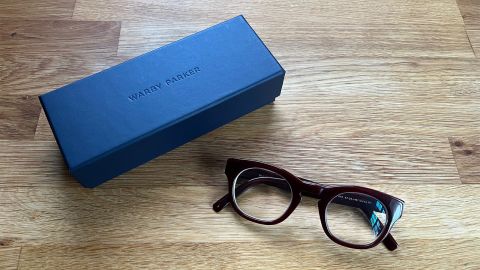
The brand most people think of when they think of buying glasses online, Warby Parker is an independent online retailer (with an expanding brick-and-mortar presence) that offers a range of house-branded stylish frames. The overall look tends toward retro styles — if you’re into chunky acetate, there’s a lot to choose from.
Warby Parker built its reputation on its home try-on program: Before the practice was widely adopted the company made it easy to try things on in person even if you don’t live near a Warby Parker location. Once you’re found some frames you’re interested in (you can follow the site’s advice about finding the best width for your face to begin narrowing things down) you put together a list of up to five frames, place a no-cost order, and the company will send out a home try-on kit of frames with clear lenses for you to check out (you can repeat the process once you return them if nothing ends up working out).
The virtual try-on tool in the Warby Parker app (this one is much better than the tool available on the desktop site, which is fairly limited) gave us a good idea of what might work for us, so we requested a home try-on kit of five likely candidates aiming for a range of sizes that would give us an idea of the overall dimensions of Warby Parker stuff, then picked one and went ahead and placed an order. Warby Parker doesn’t do any photo-based fitting based on the home-try on; the samples are strictly intended to give you a better idea of what fits and how it’ll look.
Warby Parker is an in-network provider for many insurance plans and provides links to apply for out-of-network reimbursement for many others. The company estimates you can save an average of $100 on a pair of glasses each year by using insurance, bringing its average prices down significantly, especially for single-vision prescriptions.
Like most of the retailers we checked out, pricing ranges from inexpensive (especially for basic single vision) to middle of the pack if you need anything more elaborate. You’ll spend less with Warby Parker than you would on brand name at many independent brick-and-mortar shops, though it isn’t bargain-basement either. A complete pair of glasses with a single-vision prescription with standard coatings comes in around $100. If you order a high-index progressive prescription with the full suite of coatings and a photochromic lens you’ll probably come in a bit over $400.
We quite liked the retro-styled Kimball frames we ended up ordering, though the acetate had a couple of rough edges that needed a little emery cloth and polishing (we could also have visited a Warby Parker location for this — always an option if you are near one — but chose to take care of it at home since we had tools on hand).
Warby Parker’s design approach is minimal to a fault, and the site’s clean look does a nice job setting off the frames visually, and is in keeping with the overall aesthetic, but makes some important information a little more obscure than we’d like.
Also, the shopping approach is very much mobile-first: the desktop browser version of the site’s virtual try-on tools can give you a general idea of how a frame might look, but they are much less developed than those within the Warby Parker mobile app (which does a pretty good job). We’d love to see these features brought more in line (the company has plans to do this in the coming year), and fuller information for each frame supplied in both the browser and mobile versions of the shop.
Standard measurements — lens width, bridge, and arm length — for each frame are given, but where some competitors have begun providing lens height (which isn’t part of the standard sizing given for most frames but is useful to figure out how much coverage a pair will provide for progressives or sunglasses) you’ll just have to go ahead and order the home try-on kit or visit a Warby Parker retail store to confirm what you like will work for you — that’s fine, but it makes it harder to rule frames in or out in the first round of a shopping venture. While searching the site you can filter frames by width (there are five, from extra narrow to extra wide), you can’t search the collection by size in millimeters (which is useful if you know what you like, you’re not looking to make a switch and feel confident that you like your current glasses or know exactly what you like); we appreciated this feature in our top picks’ shops.
As the pioneering independent direct-to-consumer online glasses brand, Warby Parker continues to maintain an interesting curated selection of stylish frames, at fair prices relative to bigger chains. Shopping tools are minimal, though the impact is offset a bit by its very useful home try-on kit and the option of visiting a store for fittings if you like.
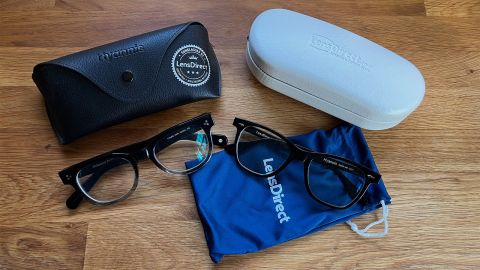
LensDirect is an independent retailer best known as an online contact lens retailer (the company has been in that business for decades), but it has moved into glasses as well, offering a small, well-curated lineup of house-branded frames tending toward chunky, retro styles.
Both pairs of glasses we got from LensDirect — a retro-styled chunky acetate frame and a Wayfarer-like sunglass frame — were of very high quality throughout (though the first pair arrived damaged and needed replacement — more on that below). Lenses were accurately cut, the finish of the frame was excellent and fit corresponded reasonably well with what we expected from given sizing and virtual try-on tools.
Pricing is middle of the range for online shops; a basic pair with single-vision lenses, no tints and standard coatings starts at $74; progressives with high-index photochromic lenses will end up in the $400 to $500 range depending on style and specifics — at least before discounts. As with many of the shops we looked at, you’ll want to look out for special offers, sales and coupon codes — the savings can be pretty significant, knocking $100 or more off the final cost.
LensDirect also offers a lens replacement service; the company will take a frame you already own (with some limitations) and replace the lenses (costs range from $59 on up to just over $300, depending on prescription type, tints and coatings), and while we didn’t test this or similar services (such as Lensabl), they’re certainly an alternative if you own expensive frames you already like that aren’t overly worn.
Since we received a damaged frame, we did need to deal with LensDirect’s customer support, and we were impressed with its handling of the situation. Every representative we interacted with was very responsive and helpful.
Only a limited selection of LensDirect’s frames allow for virtual try-on. While we found plenty of styles to our taste within this group, you may well find that the glasses that interest you aren’t available for a look. That said, measurements tracked well with what we expected given our experience of other glasses frames, so if you know exactly what you’re looking for you should be able to try similar frames in the tool to triangulate on what you want.
We didn’t love LensDirect’s prescription upload system — you upload a PDF or photo of your prescription, and once you’ve placed the order an optician contacts you by email to confirm. There’s not a good way to look back at your order to confirm that the order’s gone through with the data you intended, however. (Zenni and Eyebuydirect, for example, make all of the information you’ve entered available at every point in the process.)
This led us into making an error as we initially tried to place an order for two separate pairs of glasses with two different prescriptions, and managed to order both with the same prescription, leaving no record anywhere of the second Rx.
LensDirect has a great range of styles, and offers great-looking vintage looks at a very reasonable price once discounts are rolled in. The shopping experience is a little clunkier than our top recommendations, but we were easily able to find frames that really suited us and felt the resulting glasses were among our favorites of the group.
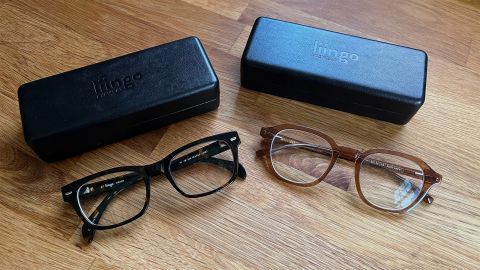
Liingo highlights their excellent home try-on program, and we felt it was a great option to have and let us get a pretty good idea of what we wanted. And if you’re not happy, they have a very generous return policy: 60 days, twice as long as most online glasses retailers, and they cover shipping.
Liingo has a solid search and shopping features, a well-thought-out virtual try-on tool that provides useful feedback on fit as well as a general guide to what size ranges will work (this was accurate in our testing, recommending a “medium” width in our case — a general recommendation, but certainly correct in the company’s sizing). A smartphone app lets you scan your current glasses (assuming you’re happy with them) to generate a prescription if you don’t have one on hand.
We requested a sample kit and ended up ordering three pairs from it, though after checking out the sample kit we decided on different frame colors. The pairs we received were all of very high quality (on par with Warby Parker’s offerings and GlassesUSA’s house brand Muse lineup) , with spring hinges, securely fitted lenses and a solid finish save for a couple of barely perceptible tooling marks.
Prices are relatively low: Basic pairs including single-vision prescriptions start at well under $100, and fully decked-out progressives with photochromic lenses will run you in the neighborhood of $400.
Liingo isn’t in-network with any insurance provider, but the company will assist you with the proper forms and an itemized receipt to submit for out-of-network reimbursement (of course you’ll want to check to make sure what your vision coverage includes).
Liingo gives you a 60-day return period, with full refunds — the longest of any of the retailers we looked at, which should give you more freedom to experiment with the frames on offer.
Liingo offers a relatively limited selection of frames compared to Eyebuydirect or Zenni. The range of styles is pretty representative of common styles, from Wayfarer-inspired styles to round and square and rectangular acetate, browline, and wireframe, but if you are looking for a wide range of funky styles or are very particular about finding a variant of something in exactly the size and shape you want, you may be out of luck.
We liked Liingo’s selection of stylish frames, and the company delivers a good quality pair of glasses for a reasonable price. Frame selection is somewhat limited, but a home try-on kit makes it easy to make decisions with confidence, as does the two-month return window.
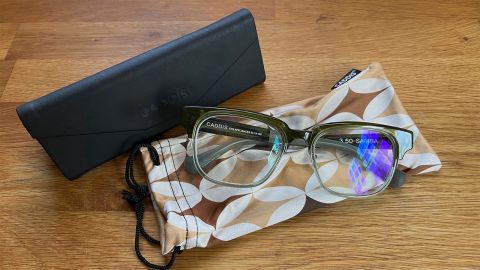
Caddis has, in the past, addressed the needs of fashionable Gen Xers and Boomers with a line of quirky readers, and introduced prescription lenses more recently. The overall aesthetic is chunky, oversized and fun, with bright colors and fanciful touches — extreme coastal grandmother, if your grandmother promoted indie shows in Portland.
Caddis bills itself as a “cult,” and the site highlights the lifestyle angle, with stories of the company’s charitable efforts, a magazine-style blog featuring the varied activities of the company’s very hip fans, playlists, some interesting culture writing and more.
We liked that once we ordered our frames, we were sent a sample along with instructions for taking a photograph for proper fitting (this is, as mentioned above, particularly helpful for setting segment height for progressive lenses). The resulting glasses we received were of very high quality and smooth finish, with a premium feel that compared to frames that cost much more. The lenses were well-cut, with a wide field of vision from distance to reading (the oversized lens are really nice for reading).
As befits the older crowd Caddis addresses, the company’s single-vision pricing is high. It’s more favorable on the high end: high-index photochromic lenses, even with a progressive prescription, top out at just over $500. If you like Caddis’s style, you’ll get your money’s worth.
Caddis has an impressive range of styles and colors, but the great majority run towards the chunky and oversized; if you’ve got a small or narrow face, you might be out of luck. The Caddis site features a ton of beautiful product photography, but the shopping experience is still a work in progress. If you browse the prescription glasses collection you won’t find any measurements — they’re only given for readers. Luckily the same frames are used for both sides of the operation, which you might not realize at first unless you do some poking around.
Caddis’s prices are relatively high at the low end: you’ll be paying about what you would at an optician, as frames with single-vision lenses begin around $250. But the glasses are of very good quality and are, in our opinion, worth the money if you like the style.
The brand doesn’t try to be all things to all people, so options are somewhat limited, but if you like the aesthetic you can’t really go wrong with Caddis’s frames, which back up their looks with solid builds and quality optics.
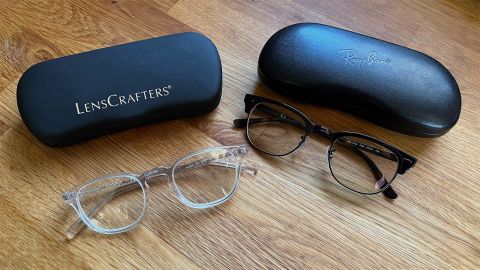
As one of the biggest optical chains in the US, LensCrafters probably needs no introduction. If you’ve ever purchased glasses, you’ve probably bought a pair from the Luxottica-owned brand. It’s moved into online retail now, providing an overall similar experience to its sibling online-only brand Glasses.com, but with the added bonus of a hybrid approach that takes advantage of its brick-and-mortar locations to get you an exam or a fitting. The site really seems built more as an entry to LensCrafters’ in-person shopping than a standalone experience (which, of course, is why Glasses.com exists).
Shopping tools are very complete and usable. The site has a wealth of informational content on pretty much every aspect of eyewear and eye care, along with the full suite of things we like: clear, easy-to-find, complete measurements for each frame; virtual try-on tools; a tool to mark favorites while shopping for easy comparison; and more. And while the company doesn’t offer samples for try-on, for many frames it will direct you to a local LensCrafters shop where you can try on in person
LensCrafters is big on options. As you might expect given how big LensCrafters is, you get a ton of options for lens types, coatings, tints and such. Where some smaller retailers offer two choices of Ray-Ban lens tints, you’ll find five at LensCrafters.
Pricing is in line with what you’d expect in store. Basic prescriptions in house-brand frames are available for $100, while premium-brand frames with progressive prescriptions and all the fixings can run in the $600-$800 range. Discount codes are readily available, however.
LensCrafters is one of the few online retailers we checked out that is in-network with a number of vision insurers, including sibling brand EyeMed. This makes it easier to save around $100 on one pair per year (the typical allotment via vision coverage), since you won’t have to apply for reimbursement as with most online opticians.
We did get very well-made glasses here, both branded (Ray-Ban, in this case) and house brand, with clean construction, well-made lenses with good optical quality and even a data sheet on lens manufacture (a curiosity for the most part, but perhaps useful for customer service or replacement in the event of an issue).
Perhaps because it is just one element of the company’s hybrid approach, the LensCrafters site is something of a work in progress. Account signup and login can be glitchy, requiring multiple attempts at username and password selection before we managed to get it working, and we were repeatedly logged out during the shopping and checkout process. We noticed that we were repeatedly recommended styles that were out of stock or discontinued. It’s possible this has to do with fluctuating in-store stock, but we didn’t run across this issue on Glasses.com.
LensCrafters’ site gives you a ton of options, but it’s a little clunky considered on its own. But it makes a lot of sense as a tool for getting set up to visit a brick-and-mortar LensCrafters shop with a clear plan of action.
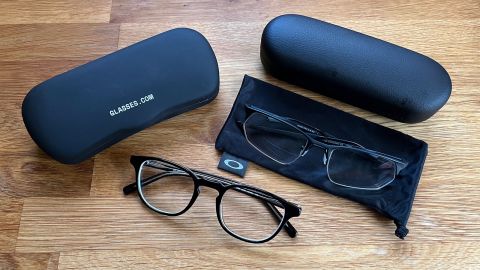
Glasses.com is the web-only retail storefront for the Luxottica brands. The offerings are similar to LensCrafters’, though you’ll find a more streamlined experience and some different models on sale between the two shops.
As you shop, you’ll want to pay attention to sales and special offers, which can reduce prices by a significant amount. We waited for a 50% off lenses offer, which we were able to couple with a 20% off total coupon, bringing the price of pair of Ray-Bans with all available options down to a very reasonable price — not quite in the Zenni range, but competitive with online-first retailers like GlassesUSA and Warby Parker.
Glasses.com is an in-network provider for a range of major insurance plans (including EyeMed, its sibling Luxottica company). so depending on your coverage you may be able to save without having to put in for reimbursement.
As with LensCrafters, we really liked the glasses we got from Glasses.com — the brand-name (Oakley in this case) and house-branded frames and lenses were well-executed, with clear optics and solid fit and finish. All spare parts for the Oakleys were included, and as with LensCrafters, you get a data sheet detailing the lens construction.
Like its sibling site LensCrafters, Glasses.com’s site is a bit of a work in progress. While shopping, we met repeated glitches like hung virtual try-on tools, and we were unpredictably and repeatedly signed out of our account. It’s annoying, and we expect will improve over time, but it introduces some unnecessary friction.
If you like LensCrafters’ selection, don’t plan on visiting a physical store and want a slightly slicker online shopping experience, Glasses.com gives you that, along with a discount structure more like other online-only direct-to-consumer brands.
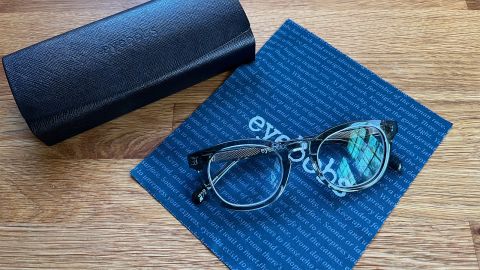
The quirky Minneapolis shop — which came to national attention as the supplier of heroic host Bernard’s readers on the Westworld series — offers a range of really interesting styles, with high-quality material, great fit and finish and refreshingly straightforward styles.
Like Caddis, Eyebobs has dug in on quirky, fun looks, with a selection of frames ranging from the chunky to the downright sculptural in a broad spectrum of colors to match (or clash productively) with any ensemble. Even the names are fun.
Since the looks on offer can be fairly extreme, Eyebobs has plenty of assistance to walk you through the process. A quiz gets you in the ballpark, and a virtual try-on tool (a little clunky on the site, but very accurate via the mobile app) gives you an accurate preview of how the frames might look on your face.
If that’s not sufficient, Eyebobs has a team of personal stylists to assist you. During the shopping process, you can set up a free appointment to talk through some frames that might suit your personal taste (even if you might not think so at first).
Pricing is simple and reasonable, if not cheap. All of Eyebobs’ frames (save for designer collaborations like the current Lake & Harriet line) are priced the same: Readers are $95, sunglasses $135, basic single-vision pairs start at $245 and pairs made with all of the possible options (high-index photochromic progressives) top out at $485.
We ordered a pair of Waylaid readers (one of the brand’s signature styles) in a crystal gray shade that — while not on the more extreme end of Eyebobs’ style — suited our look. They arrived within a week; the fit lined up perfectly with our expectations based on try-on with the mobile app, and we were impressed with the fit and finish.
Eyebobs’ personal stylist service has some scheduling glitches and we found it impossible to actually get in touch with a stylist. It’s not clear from the email invitation that you need to log into the site and confirm your appointment, or where to obtain the meeting address itself. It’s a great idea, but the implementation needs work.
If you’re looking for something that grabs attention, whether with bright colors or sculptural shapes, Eyebobs has you covered. Good shopping and fit tools, fair pricing and a simple process make it easy to experiment.
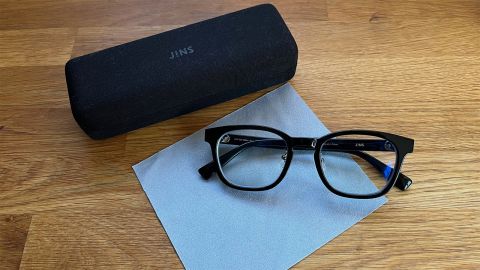
Jins, a Japanese brand with New York City, San Francisco, and Los Angeles retail stores, concentrates on classic looks in wire and plastic, generally offering similar styles in standard and oversized versions. While more and more brands offer low-bridge fits nowadays, Jins has focused on flexible, inclusive fitting more than any other brand we ran across; even many of their acetate frames have adjustable nose pads, and many others are offered in multiple fit options.
The Jins site is very clear and simple to shop. Search tools are effective; full measurements are given for each frame in a clear, easy-to-navigate layout; a favorites collection tool lets you put interesting frames aside for later comparison; and virtual fit tools are fast and accurate.
Jins’ range of fit is impressive. While our acetate frames fit out of the box without adjustment, they offered a lot more range than many similar models we looked at from other manufacturers given the addition of large adjustable nose pads as used on many wire and browline styles. This makes the frames a little bulkier, but if you’ve had trouble finding a good fit, it is likely worth it, and the streamlined styles are very accommodating.
Pricing is relatively inexpensive, with single-vision pairs available starting at $90; progressive photochromics can run between $330 and $430, depending on frame selection. They also come with a 30-day warranty.
Jins has had stock issues lately and has run into some shipping delays. To their credit, Jins warned us of this during the ordering process and estimated that our pair of readers might take as long as a month to arrive. That said, our order arrived in just over two weeks, which was a pleasant surprise. At time of publication it looked like many styles were out of stock, at least in some colors, so it’s worth browsing with an open mind.
If you’re in need of stylish frames with a low nose-bridge fit, you’ll find a treasure trove of options at Jins. Just be aware that frames go out of stock quickly and be flexible on colors and styles and you’ll likely find a frame you’ll like.
High-end luxury styles from home: Alexander Daas
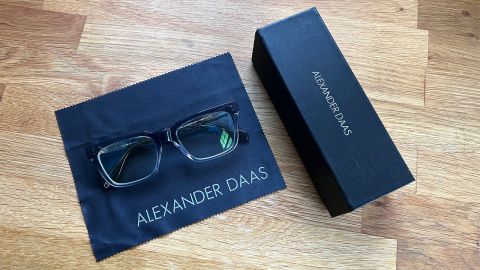
Alexander Daas, a California-based high-end optician with a celebrity following, has moved into full-service online retail, offering their own house brand along with a full range of other luxury brands. It’s not cheap — in fact, it’s about as expensive as you’d expect given the lineup — but they make a great pair of glasses and if you’re interested in high-fashion brands and your local doesn’t carry them, Alexander Daas can provide those options at a distance. It isn’t for everybody, but it’s an interesting option for very high-quality frames.
While the site experience is very minimal, ordering is straightforward, with clearly laid-out options for choosing lens materials, coatings and so forth. Prescription entry is via upload of an image — not our favorite sort of system, but customer service is very responsive and followed up by email to confirm within a day.
Also, once we placed our order, we received a pair of sample frames of the style we’d ordered, along with instructions on taking a photo to set segment height (we ordered a progressive prescription). We followed the directions, submitted photos and got a confirmation from an optician same day. The finished glasses arrived in just over a week.
The glasses we received from Alexander Daas were of very high quality — possibly the best construction and finish of anything in the test group. Lenses had great clarity as well. We’d ordered all of the options — thin photochromic lenses along with blue-light filtering — and were impressed by the optical clarity.
The shopping experience is pretty basic. You don’t get elaborate search tools, just filtering by brand, material and style. The idea is that you’ll be choosing primarily on aesthetics in any case, but especially given the brand’s emphasis on carrying a range of fits (and they advertise their broad selection of frames with narrow sizes meant for people with smaller faces), it would be nice to see full measurements and a tool to search by size (or better yet, a virtual try-on feature).
Pricing is on par with high-end brick-and-mortar opticians. Frames begin at around $240 before lenses, and range on up past $700, so once you add your prescription and whatever tints and coatings you need, it’s easy to end up north of $1,000.
If you’ve got luxury taste (and the budget to match) but don’t have access to a high-end optician in your area, Alexander Daas has you covered — and they make a great pair of glasses.
First off, we can’t tell you what you like. If you’re like us, you wear glasses every day, and choosing a pair of frames has mostly to do with your personal style — which is why it’s great that there are a ton of good online retailers, since you get broad access to an endless range of looks.
All of the retailers we looked at for this review were able to deliver a well-cut prescription in a timely fashion. Thus in our testing we focused on which retailers provided the best overall retail experience, ensuring that we’d get a great pair of frames built with a perfectly executed prescription and the options we’d requested, comparable to what we’d get from a brick-and-mortar optician.
What did we find? Basically, online shoppers are spoiled for choice and anyone who lives outside of a major urban center will likely find a bigger range of styles and fits online than they will locally. We’ve zeroed in on the best of the bunch, and no matter what you’re looking for and what size your budget, we should be able to point you in the right direction.
That depends. If you shop around online, it’s very likely that you will save money versus purchasing at your local optician — though exactly how much will depend on a few factors.
If you have a simple prescription — single vision, below +/- 4.00 — and don’t want an ultra-thin lens or special coatings or tints, across the board you’ll likely spend around $100. Should you need something more complex, you’ll spend more, though likely less than you would on brand-name pairs at a local optical shop.
You do give up the benefits that come with in-person fitting, dispensing and adjustments, though these matter less if you have a straightforward single-vision prescription, and depending on your budget it may well be worth spending more to have access to a knowledgeable professional.
If you’re interested in brand names, you should watch for sales, coupons and discount codes as you would with any other online shopping. Over the course of our testing, we were typically able to find discounts of up to 40% off the price of our orders. Many retailers also offer second pairs at a steep discount, so it’s worth keeping an eye out.
An open question is insurance, which can cover a significant amount at most brick-and-mortar opticians, narrowing the gap pretty significantly with online offerings. That said, depending on your coverage and where you shop, you might get a break on your online order too. Insurance plans typically cover one pair of glasses per year (though generally only a portion of the cost, usually around $100).
Most low-cost retailers — Zenni, for example — don’t accept insurance (they aren’t in-network with any plan). Some (GlassesUSA, for instance) ease the process of asking for out-of-network reimbursement via many plans with convenient links to the necessary forms.
You’ll have the easiest time with insurance if you go with the brick-and-mortar hybrids or retailers associated with the big optical corporations. LensCrafters and Glasses.com are in-network providers for a number of popular insurance plans (and are sibling brands of EyeMed). VSP, another major insurer, runs its own online store, Eyeconic.
Get your prescriptions and measurements in order
If you plan to buy glasses online, you can go get an eye exam anywhere you like, get a prescription and use it anywhere you like. The FTC’s Eyeglass Rule requires any eye doctor you see to provide you with a prescription. Easy enough.
But you need another measurement to get a pair of glasses made accurately: your pupillary distance (PD) — the distance between the centers of your pupils. While the optometrist and ophthalmologist we saw locally were happy to provide this number for us, this can be more difficult to obtain, especially if you get your eye exam through a doctor whose practice is housed within or linked to a dispensing optician. Dispensing opticians have long argued that the PD measurement is part of the fitting process and not part of the prescription, and most states have not defined it as such, putting it in a gray area.
Brick-and-mortar shops are sometimes reluctant to give PD information to a patient who isn’t a glasses customer, out of the understandable fear that they’re giving up business and that they may be held liable in the event that whoever does fill the prescription may do substandard work. That said, many doctors do understand that patients want freedom of choice as to where to shop, and you should absolutely ask.
If you can’t get your PD from your doctor, however, you can take the measurement yourself, either using a ruler (this is much easier to do if you can get somebody to help) or by marking a current set of glasses and checking your focus (which takes some practice).
Since it’s difficult to be precise, many online glasses retailers have made taking a PD measurement even simpler, offering tools within their browser and mobile apps to take these measurements, typically based on webcam or phone camera photos taken with a reference card in the frame. We tried these in every case they were available, and each time got a measurement that corresponded with our ophthalmologist-provided PD (we visited an independent doctor who does not dispense).
One note: On our own we weren’t able to capture this in the same detail as we were able to get at the ophthalmologist, who measured us at a slightly asymmetrical 62 mm/ 63 mm split. That said, we were unable to notice the difference in lenses made with and without the asymmetry, and many vendors don’t accept a two-number measurement in any case, saying (as did the optometrists we spoke to) that such a small difference is unlikely to be perceptible in a lens, especially if you wear single-vision.
Pupillary distance asymmetries are more important to get just right if you wear progressives (and your PD will be slightly different for distance and close-up vision, making for a more complicated measurement). If you’ve got a complex prescription you may want to consult an independent ophthalmologist to make sure you have the most precise measurement.
If you do wear progressives or bifocals, you may want to look for one of the few online retailers (Caddis and Alexander Daas for example) who take an additional measurement in order to set the segment height and lessen the chance that you’ll have to send them back for adjustment. This typically involves sending you a sample frame to physically try on and having you submit a photo of you wearing them. Retailers who sell online but also have brick-and-mortar locations (Warby Parker, LensCrafters/Glasses.com) can provide this service in person as well as part of a traditional in-person fitting.
Roka formerly offered this sort of service, but has dropped it since we tested; their representative told us that their in-house algorithm did a more consistent job of setting segment height than they were able to do using photos, given that the customer-submitted photos varied so much in lighting, quality of focus and so on.
That said, we got perfectly usable lenses in all cases, regardless of how this measurement was taken or synthesized.
Transitions lenses and various other light-reactive or “photochromic” lens formulations have been around since the mid-1960s, and while they’ve had a reputation for dowdiness they do come in handy if you drive or spend time outdoors and don’t want to carry around an extra pair of glasses.
Older versions of the technology never quite got clear indoors, and for that reason many have avoided them, not wanting to look like they were Hollywood stars trying pretending to stay incognito (one Underscored staffer dismissed a pair out of hand, saying, “Who are these for, Elton John?”). The bigger issue affecting their usefulness is the fact that most formulations don’t get dark in the car (because of UV protection film applied to windshields), keeping them from working in one of the most useful applications for sunglasses.
New formulations do solve this problem. We suggest looking out for a shop that offers Transition’s XtraActive treatment, which in our testing darkens quickly in a car (and, to some extent, indoors in brightly sunlit rooms), We didn’t find it offered widely yet, but it’s worth it if you’re in and out of the car or on and off the bike a lot during your day.
Luxottica and the independents
As you may have read, the Italian company Luxottica owns a big share of the optical business worldwide. Exactly how big a share isn’t quite clear, and there are other big optical groups like Optimax out there as well, but a lot of recognizable brands are under the Luxottica umbrella.
Aside from owning a whole lot of popular eyewear brands such as Ray-Ban, Oliver Peoples, Persol and many others, it owns a big portfolio of retailers, including LensCrafters, and it’s moved into online retail as well, with both LensCrafters’ own site and the more digital-first Glasses.com. Whatever opinion you may hold as to the meaning of Luxottica’s presence in the industry, their brands are very popular, and should you be interested in them, the company’s own retail outlets are an option.
There are many independents to choose from — including major digital retailers Warby Parker and Zenni — who don’t carry any Luxottica or Optimax brands, but focus on their own house-brand offerings. Other independents may carry a mix.
We began by researching the online eyeglass retail landscape and putting together a list of the best-regarded and most popular premium and discount online-first retailers as well as mainstream and luxury brick-and-mortar opticians that offer a full online shopping experience without requiring a store visit.
While doing this round of research, we got an eye exam from a local provider, so we could begin with a fresh prescription. The ophthalmologist we saw provided PD along with the prescription, so we were able to begin the process with all the data we needed. We obtained two prescriptions, both progressive: one for general distance viewing and the other for mid-range/computer/desk use. Where it was possible to order two or more pairs with separate prescriptions in a single purchase we attempted to do so.
Once we arrived at our final list, we then went ahead and placed at least one order with each retailer. Since we can’t account for everyone’s sense of style, we ordered frames in styles, shapes and materials that we were accustomed to, including a range of wire, acetate, nylon and rimless models.
Where possible, to get a sense of the range of a retailer’s representative offerings, we ordered two pairs: one with the most affordable frames offered, standard lens thickness and no additional coatings and another with a premium frame with high-index lenses and the full complement of additional coatings offered. Where retailers offered curved exercise-oriented glasses (which can be difficult to find even through brick-and-mortar retailers) we ordered a pair.
We made careful notes on the ordering experience, trying out any virtual fitting tools across a range of styles, noting whether the site allowed for easy shopping of and comparison between multiple styles and reading through each site’s range of educational and informational material to assess its usefulness.
When they were offered, we made appointments for and took advantage of remote fitting services. Since we were looking for the most generalizable experience, we did not use any brick-and-mortar resources.
Source: https://www.cnn.com/cnn-underscored/reviews/best-online-prescription-glasses?iid=CNNUnderscoredHPcontainer















